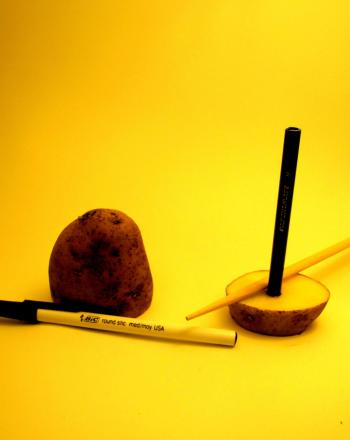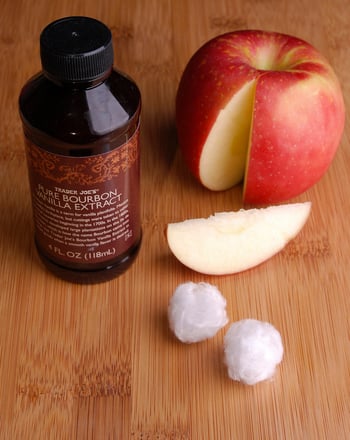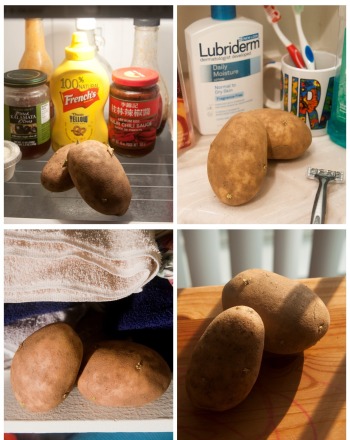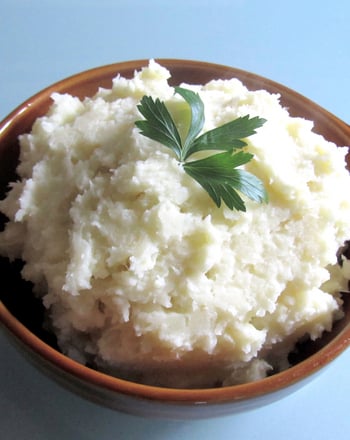Science project
Potato Chip Science: How Greasy Are Your Potato Chips?
Potato chip science is big business! The FDA (Food and Drug Administration) does some very important tests so that the food you eat—including potato chips—is accurately labeled. We may not have access to the FDA’s expensive machines, but we can still do some pretty cool tests without them.
For this science fair project, let’s assume you’re a scientist working for the FDA and that you need to double-check the fat content (or “greasiness”) of several brands of potato chips. If you don’t have any specialized machines, then how do you find out how much grease your chips have?
One thing we could try is to simply mash up a potato chip and look at how much grease comes out. Paper absorbs grease really well, so we can use it as our “instrument” to help us quantify—or find a number that describes—how much grease is in an individual chip.
But wait a minute. Not all potato chips are the same size! Even chips from the same bag come in different sizes, and of course, different brands usually make differently sized chips. If we were to test a really big chip, we would get more grease than if we tested a small one, and this certainly wouldn’t describe how much grease is in a single serving of chips very well. So what’s a good way to determine how much grease is in your potato chips?
We can calculate a useful number known as an average to describe how much grease we have in our chips. We can find the average by adding together all of the grease we find divided by the number of chips we used to get that much grease.
Problem:
How greasy are different brands of potato chips?
Materials:
- Several bags of potato chips (different brands)
- Something to write with
- Rolling Pin
- Wax Paper, plastic wrap, or large sandwich bag
- Graph paper
- Tape
- Window
- Sunlight
Procedure:
- Find the serving size listed in the nutrition facts for each brand of chips.
- Write down the serving size for each brand. If we’re trying to determine if a serving of one brand of chips is greasier than another, why do you think recording the serving size for each brand of chip is important?
- Find the total fat per serving for each brand of chips, in grams. Record this number.
- Pick a brand of chips. Count out a number of chips equal to the serving size for that brand. Make sure to pull chips randomly from the bag. Don’t pick big or small ones, specifically. If we want to take an accurate average, why do you think this is important?
- Place the chips on a sheet of graph paper. Record the amount of chips you pulled out for this brand of chips.
- Lay the wax paper, plastic wrap, or large sandwich bag over the chips.
- Use this time to formulate your hypothesis. Which brand of chips do you think will be the greasiest?
- Roll over the chips several times with the rolling pin, making sure they’re totally pulverized.
- Remove the graph paper and throw away the chips. Tape the graph paper to a window (or the surface of your school’s overhead projector, if you have access to one).
- Count the number of squares that are translucent from the grease. (Hint: make a check mark in each square you’re counting. You can use a pencil, pen, or grease pencil if you’re marking the graph paper itself. If you’re using an overhead projector, you can use a dry-erase marker to mark squares projected onto the whiteboard.) Only count squares that are ½ full or more. Record the number of squares you count for this brand.

- Repeat steps 4-10 for each brand.
- The average grease per serving size is simply the amount of squares you counted for each brand. To calculate the average grease per chip, divide squares counted by the number of chips tested. Record this number for all brands in your data chart.
- Draw a graph like the one below comparing the listed fat value per serving for each brand of chips and the number of squares you counted when you did the experiment. Does the data surprise you, or is it what you expected? What does it suggest about the accuracy of your measurements?

Results:
Your results should roughly reflect the amount of fat listed in the nutrition facts for each brand of chips.
Why:
Here’s another way to think about how averages work: since we grabbed a big handful of chips without looking, we got some chips that were big, some that were small, and some that were medium in size. Because we have a lot of differently-sized chips to average together, we can say that any given chip is “about this big.” If we only had two chips it would be hard to pick which one is the closest to the “normal” size, but if we had a lot of them it would be pretty easy to find one good, average size that describes them all pretty well. This is a simple example of the Law of Large Numbers: the more things we test (and the more times we test them), the more accurate our calculated average will be.
Scientists use averages all the time, because the world often doesn’t behave consistently enough to give us exactly the same number every time we do an experiment. Gas mileage, nutrition facts, school grades, and even things like radiation flux for spaceships are all based off of averages. Averages are a way to find numbers that are “characteristic” of a situation or sample, meaning that these numbers closely describe that situation, even if we can’t always predict the exact number we will get each time we perform an experiment!
So what other factors might have influenced our results? We made sure to pulverize each chip so that it released most of its grease, but if your results didn’t match up with what was on the bag, it may be because certain chips release grease better than others when crushed. If you want, you can repeat this experiment and crush each chip even more. See if your results change, and take note of this in your write-up for your project.
There are countless ways to expand this experiment. What if we tried to figure out how greasy a given brand of chips was by weight, as opposed to serving size? This is a useful thing to measure, because some serving sizes might be bigger or smaller than others. We could calculate this measurement by dividing the amount of squares we counted by the number of grams that make up a serving size. We could even get a more accurate measure of greasiness by using a food scale to measure out grams, rather than counting the FDA’s estimated amount of chips that make up a serving size. Remember, the FDA calculated this number by taking an average! This experiment could even be expanded to test how accurate the FDA’s approximate serving sizes are. Can you design an experiment to investigate this using a food scale?
Education.com provides the Science Fair Project Ideas for informational purposes only. Education.com does not make any guarantee or representation regarding the Science Fair Project Ideas and is not responsible or liable for any loss or damage, directly or indirectly, caused by your use of such information. By accessing the Science Fair Project Ideas, you waive and renounce any claims against Education.com that arise thereof. In addition, your access to Education.com's website and Science Fair Project Ideas is covered by Education.com's Privacy Policy and site Terms of Use, which include limitations on Education.com's liability.
Warning is hereby given that not all Project Ideas are appropriate for all individuals or in all circumstances. Implementation of any Science Project Idea should be undertaken only in appropriate settings and with appropriate parental or other supervision. Reading and following the safety precautions of all materials used in a project is the sole responsibility of each individual. For further information, consult your state's handbook of Science Safety.













